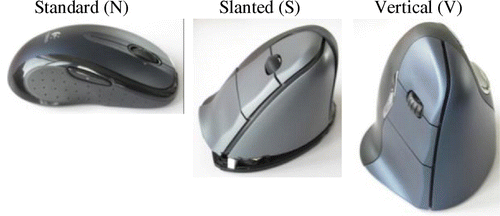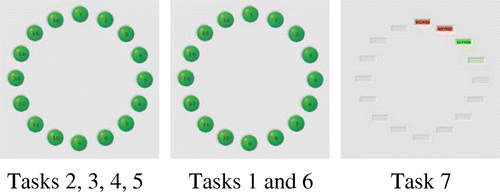1. Introduction
In 2013, 74% of women and 68% of men in France used a computer professionally (DARES Citation2015). Pointing tools are essential to performing a majority of computing tasks today. Hence, 68% of women use a static computer workstation and a mouse pointing tool compared with 55% of men (DARES Citation2010). A standard mouse slants 0° to the horizontal and its usage requires full pronation of the forearm. ISO Standard 9241-410 (Citation2008) states that ‘the neutral posture, or most relaxed posture of the forearm, is believed to be with the hands about 30° from vertical’ (i.e., 60° from the horizontal). Based on this information, many mouse models have been designed to reduce the full forearm pronation required to manipulate a standard mouse. Prime commercial arguments include enhanced posture and curtailed development of musculoskeletal disorders (MSD). The aim of this study was to compare carp extensor activity and wrist angles, when performing work common tasks with three different mice.
Table 1 Results of ANOVA of percentiles for ECU and ECR, mean deviations of wrist EXT and AA angles,when performing the 7 tasks using 3 mice. ‘-’ = insignificant; X > Y indicates that mouse X generated greater values than mouse Y.
2. Methods
2.1 Subjects
Eighteen right-handed female volunteers took part in the experiment. Their average age was 28.4 ± 4.8 years and body mass index 22.2 ± 2.3 kg/m². They formally agreed to take part in the experiment, which was approved by the local Research Ethics Board.
2.2 Workstation
The workstation included a desktop, a screen monitor, a keyboard and a chair adjusted to each subject’s anthropometric measurements. The computer mouse was placed on right side of the keyboard. Three mice were studied: a standard (N) mouse, a slanted (S) mouse angled 35° and a vertical (V) mouse angled 65° to the horizontal (Figure ).
2.3 Tasks performed
Each subject performed seven tasks with all three mice. The specific action of each task was repeated without stopping on 16 consecutively numbered targets (figure ): Task 1 involved pointing targets, Task 2 involved pointing a target then clicking on the left button, Task 3 involved pointing a target then clicking on the right button, Task 4 involved pointing a target then double clicking on the left button, Task 5 involved pointing a target, clicking on the left button then on the right button, Task 6 involved pointing a target, clicking on the left button then dragging the target onto the next target and, finally, Task 7 involved grasping the mouse then pointing to an entry field, selecting it by clicking on the left button (and writing a number, this action was not considered in our analyse). These tasks are commonly used when searching for information on a computer or during computer-aided design work.
2.4 Methods used
Extensor carpi ulnaris (ECU) and extensor carpi radialis (ECR) right were measured. A portable sEMG signal analysis system (Noraxon 1-08) and bipolar electrodes (FIAB F3010) were used. Electrodes were placed as recommended by Zipp (Citation1982). The signals were band-pass filtered in the 10-1000 Hz frequency range, sampled at 2000 Hz and amplified 1000 times. The root-mean-square values were calculated over 100-ms sliding windows in 0.5-ms steps. Maximum voluntary electrical (MVE) activity was performed for each muscle to standardise the sEMG signals. The right wrist extension (EXT) and abduction-adduction (AA) angles were measured using a goniometer (SG110 biaxial model, Penny and Giles). Data were continuously recorded based on a 200-Hz sampling frequency.
2.5 Data analysis
The amplitude distribution function was applied to each muscular activity to determine the 10th, 50th and 90th percentiles for the sEMG signal. These were compared with thresholds proposed by Jonsson (Citation1978) to prevent muscular fatigue. According to the latter author, the 10th percentile for muscular activity should not exceed 5% and/or the 50th percentile 14% and/or the 90th 70% of the MVE. The mean EXT and AA wrist angles were compared with the values recommended in ISO Standard 11228-3 (Citation2007), in which the comfort zone is defined as below 45° flexion, 45° extension, 20° adduction or 15° abduction. These data were analyzed based on a 2-way mixed-effects ANOVA. The data for each task were analysed as a function of the mouse model and subject as well as for the mouse × subject interactions.
3. Results and Discussion
ECU and ECR muscular activities were higher with the N than with the V and/or S mouse, when performing Tasks 1, 2, 3 and 6. Thus, regardless of carpal extensor muscles activity, S or V mouse usage should be preferred to N mouse usage. Wrist EXT angle was greater with the V and/or S mouse than with the N mouse, when performing Tasks 1, 2 and 7. With the N mouse, extensor muscle activity allows wrist extension and tires the hand, whereas with the V or S mouse, wrist extension is due to a passive mechanism linked to mouse position in the hand; the weight of the hand need not be supported.
Wrist adduction was greater with the N mouse than with the V and/or S mouse, when performing Tasks 1, 2, 3, 4, 5 and 6. This can be explained by the position of the hand: when using the V and S mouse-models the little finger and wrist effectively rest on the edge of the mouse, thereby reducing wrist adduction. For each task performed and each mouse used, the mean of the wrist angle in the EXT and AA planes fell within the comfort zone (all tasks combined mean EXT: N = 35.9 ± 1.5, S = 39.8 ± 1.4, V = 40.0 ± 1.8; mean AA (abduction (+)): N = 5.7 ± 8.3, S = 2.6 ± 7.5, V = 2.8 ± 10.2). Regardless of the task and the mouse-model, the 10th percentile for the ECU and ECR exceeded the threshold proposed by Jonsson (Citation1978) in relation to preventing muscular fatigue (all tasks combined mean of 10th percentile for ECU: N = 8.5 ± 2.6, S = 8.8 ± 2.3, V = 8.5 ± 2.7; for ECR: N = 8.9 ± 2.8, S = 8.5 ± 2.5, V = 8.6 ± 2.9). Thus, alternation of the hand operating the mouse, introduction of work breaks and/or other tasks less stressful for carpal extensor activity could prompt adequate recovery times. Moreover, muscular carpal activities and wrist angles were different depending on the task.
4. Conclusions
These 7 tasks are usually combined in a work activity. Our results show that a slanted or vertical mouse should be favoured over a standard mouse. However, whatever the tasks performed and the mouse-model used, there is always high activity of carpal extensor muscles, which could eventually lead to muscular fatigue or MSD. Use of another pointing device, alternating the hand operating the mouse, introducing work breaks and/or other tasks could reduce muscular carpal extensor activity and thus prompt adequate recovery times.
References
- DARES. 2010. “Les femmes occupent des emplois où le travail semble moins épanouissant.” Analyses n°082, 10p.
- DARES. 2015. “Intensité du travail et usages des technologies de l’information et de la communication.” Synthèse stat’ n°14, 271p. https://dares.travail-emploi.gouv.fr/dares-etudes-et-statistiques/etudes-et-syntheses/
- ISO 11228-3. 2007. “Ergonomics – Manual handling – Part 3: Handling of low loads at high frequency.” Geneva
- ISO 9241-410. 2008. Ergonomics of Human-system Interaction – Part 410: Design Criteria for Physical Input Devices. Brussels: AFNOR.
- Jonsson B. 1978. Quantitative electromyographic evaluation of muscular load during work. Scandinavian Journal of Rehabilitation Medicine Supplement. 6: 69–74.
- Zipp P. 1982. Recommendations for the standardization of lead positions in surface electromyography. European Journal of Applied Physiology and Occupational Physiology. 50: 41–54.10.1007/BF00952243


